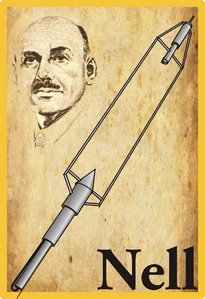Senior Space Cadet
Well-Known Member
- Joined
- May 23, 2020
- Messages
- 717
- Reaction score
- 310
I'm still intrigued by the idea of tractor motors. That is, motors toward the front of the rocket, eliminating the need for added weight in the nose and an inherent increase in stability (see arguments for FWD and bottle rockets).
The problems are, at least, two fold.
Problem one: At least two engines is nearly mandatory, unless your were making a glider. Any difference in power would result in a curved trajectory. As I said before, spinning would reduce that effect.
Problem two: The flame from the engines might start the body, or fins, of the rocket, on fire, but spacing the motors out from the body would reduce this risk but increases the likelihood of the first problem.
Possible solutions:
Don't use a central body tube. Instead, use stick balsa. This gets the engine thrust closer to the centerline. It would also give you a more solid way of attaching four fins (against the four sides of the square balsa stick).
Use heat resistant stove paint to paint the lower part of the rocket. Yes, color choices are limited (It comes in any color you want as long as it's black) and probably only comes in satin and flat. Hopefully I'm wrong about color selection.
Another possible design would be to use a rectangular balsa stick and use two fins, such that the motors don't point at the fins. Possible?
Potentially, you could use four motors. I'd have to experiment with how large the central balsa stick would need to be.
Something different to think about and experiment with.
As I said before, but didn't fully believe myself, it seems like everything has been done before. I'll be waiting for the photos of stick rockets you guys have.
The problems are, at least, two fold.
Problem one: At least two engines is nearly mandatory, unless your were making a glider. Any difference in power would result in a curved trajectory. As I said before, spinning would reduce that effect.
Problem two: The flame from the engines might start the body, or fins, of the rocket, on fire, but spacing the motors out from the body would reduce this risk but increases the likelihood of the first problem.
Possible solutions:
Don't use a central body tube. Instead, use stick balsa. This gets the engine thrust closer to the centerline. It would also give you a more solid way of attaching four fins (against the four sides of the square balsa stick).
Use heat resistant stove paint to paint the lower part of the rocket. Yes, color choices are limited (It comes in any color you want as long as it's black) and probably only comes in satin and flat. Hopefully I'm wrong about color selection.
Another possible design would be to use a rectangular balsa stick and use two fins, such that the motors don't point at the fins. Possible?
Potentially, you could use four motors. I'd have to experiment with how large the central balsa stick would need to be.
Something different to think about and experiment with.
As I said before, but didn't fully believe myself, it seems like everything has been done before. I'll be waiting for the photos of stick rockets you guys have.






